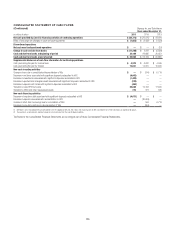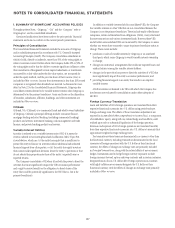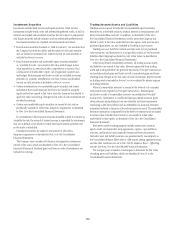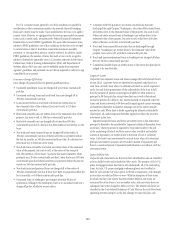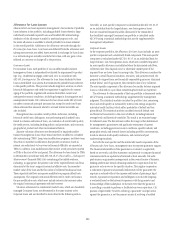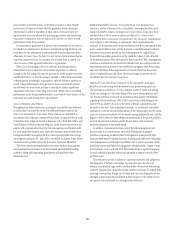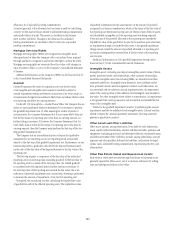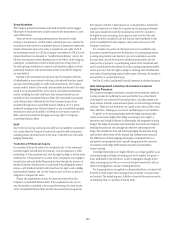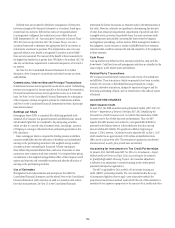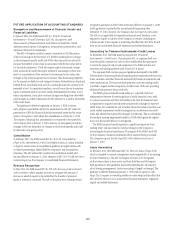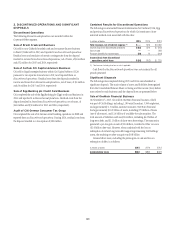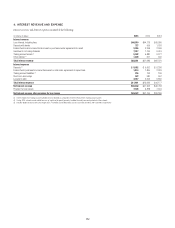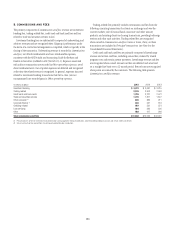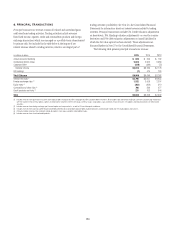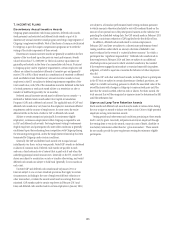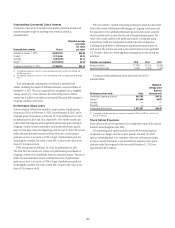Citibank 2015 Annual Report Download - page 164
Download and view the complete annual report
Please find page 164 of the 2015 Citibank annual report below. You can navigate through the pages in the report by either clicking on the pages listed below, or by using the keyword search tool below to find specific information within the annual report.146
Deferred taxes are recorded for the future consequences of events that
have been recognized for financial statements or tax returns, based upon
enacted tax laws and rates. Deferred tax assets are recognized subject
to management’s judgment that realization is more-likely-than-not.
FASB Interpretation No. 48, “Accounting for Uncertainty in Income Taxes”
(FIN 48) (now incorporated into ASC 740, Income Taxes), sets out a
consistent framework to determine the appropriate level of tax reserves to
maintain for uncertain tax positions. This interpretation uses a two-step
approach wherein a tax benefit is recognized if a position is more-likely-
than-not to be sustained. The amount of the benefit is then measured to be
the highest tax benefit that is greater than 50% likely to be realized. ASC 740
also sets out disclosure requirements to enhance transparency of an entity’s
tax reserves.
See Note 9 to the Consolidated Financial Statements for a further
description of the Company’s tax provision and related income tax assets
and liabilities.
Commissions, Underwriting and Principal Transactions
Commissions revenues are recognized in income when earned. Underwriting
revenues are recognized in income typically at the closing of the transaction.
Principal transactions revenues are recognized in income on a trade-date
basis. See Note 5 to the Consolidated Financial Statements for a description
of the Company’s revenue recognition policies for commissions and fees,
and Note 6 to the Consolidated Financial Statements for details of principal
transactions revenue.
Earnings per Share
Earnings per share (EPS) is computed after deducting preferred stock
dividends. The Company has granted restricted and deferred share awards
with dividend rights that are considered to be participating securities,
which are akin to a second class of common stock. Accordingly, a portion
of Citigroup’s earnings is allocated to those participating securities in the
EPS calculation.
Basic earnings per share is computed by dividing income available to
common stockholders after the allocation of dividends and undistributed
earnings to the participating securities by the weighted average number
of common shares outstanding for the period. Diluted earnings per
share reflects the potential dilution that could occur if securities or other
contracts to issue common stock were exercised. It is computed after giving
consideration to the weighted average dilutive effect of the Company’s stock
options and warrants and convertible securities and after the allocation of
earnings to the participating securities.
Use of Estimates
Management must make estimates and assumptions that affect the
Consolidated Financial Statements and the related Notes to the Consolidated
Financial Statements. Such estimates are used in connection with certain
fair value measurements. See Note 25 to the Consolidated Financial
Statements for further discussions on estimates used in the determination of
fair value. Moreover, estimates are significant in determining the amounts
of other-than-temporary impairments, impairments of goodwill and other
intangible assets, provisions for probable losses that may arise from credit-
related exposures and probable and estimable losses related to litigation
and regulatory proceedings, and tax reserves. While management makes its
best judgment, actual amounts or results could differ from those estimates.
Current market conditions increase the risk and complexity of the judgments
in these estimates.
Cash Flows
Cash equivalents are defined as those amounts included in Cash and due
from banks. Cash flows from risk management activities are classified in the
same category as the related assets and liabilities.
Related Party Transactions
The Company has related party transactions with certain of its subsidiaries
and affiliates. These transactions, which are primarily short-term in nature,
include cash accounts, collateralized financing transactions, margin
accounts, derivative transactions, charges for operational support and the
borrowing and lending of funds, and are entered into in the ordinary course
of business.
ACCOUNTING CHANGES
Debt Issuance Costs
In April 2015, the FASB issued Accounting Standards Update (ASU) 2015-03,
Interest—Imputation of Interest (Subtopic 835-30): Simplifying the
Presentation of Debt Issuance Costs, to conform the presentation of debt
issuance costs to that of debt discounts and premiums. Thus, the ASU
requires that debt issuance costs related to a recognized debt liability be
presented in the balance sheet as a direct deduction from the carrying
amount of that debt liability. The guidance is effective beginning on
January 1, 2016; however, Citi elected to early adopt the ASU on July 1, 2015
which resulted in an approximately $150 million reclassification from
Other assets to Long-term debt. The retrospective application was deemed
immaterial and, as such, prior periods were not restated.
Accounting for Investments in Tax Credit Partnerships
In January 2014, the FASB issued ASU No. 2014-01, Investments—Equity
Method and Joint Ventures (Topic 323): Accounting for Investments
in Qualified Affordable Housing Projects. Any transition adjustment
is reflected as an adjustment to retained earnings in the earliest period
presented (retrospective application).
The ASU is applicable to Citi’s portfolio of low income housing tax
credit (LIHTC) partnership interests. The new standard widens the scope
of investments eligible to elect to apply a new alternative method, the
proportional amortization method, under which the cost of the investment is
amortized to tax expense in proportion to the amount of tax credits and other


